Mazda CX-5 Review 2024
Written by Andy Brady
Quick overview
Pros
- Ultra stylish and comfortable interior
- Great to drive with strong diesel engines
- Very safe with five-star Euro NCAP safety rating
Cons
- You can't buy a hybrid
- No seven-seater
- Media system in early models isn’t as good as rivals
Overall verdict on the Mazda CX-5
"The Mazda CX-5 is no spring chicken, especially when compared with tempting newer rivals, but we reckon it's still a very appealing family car, with a spacious, smartly trimmed cabin, good looks and an enjoyable driving experience."
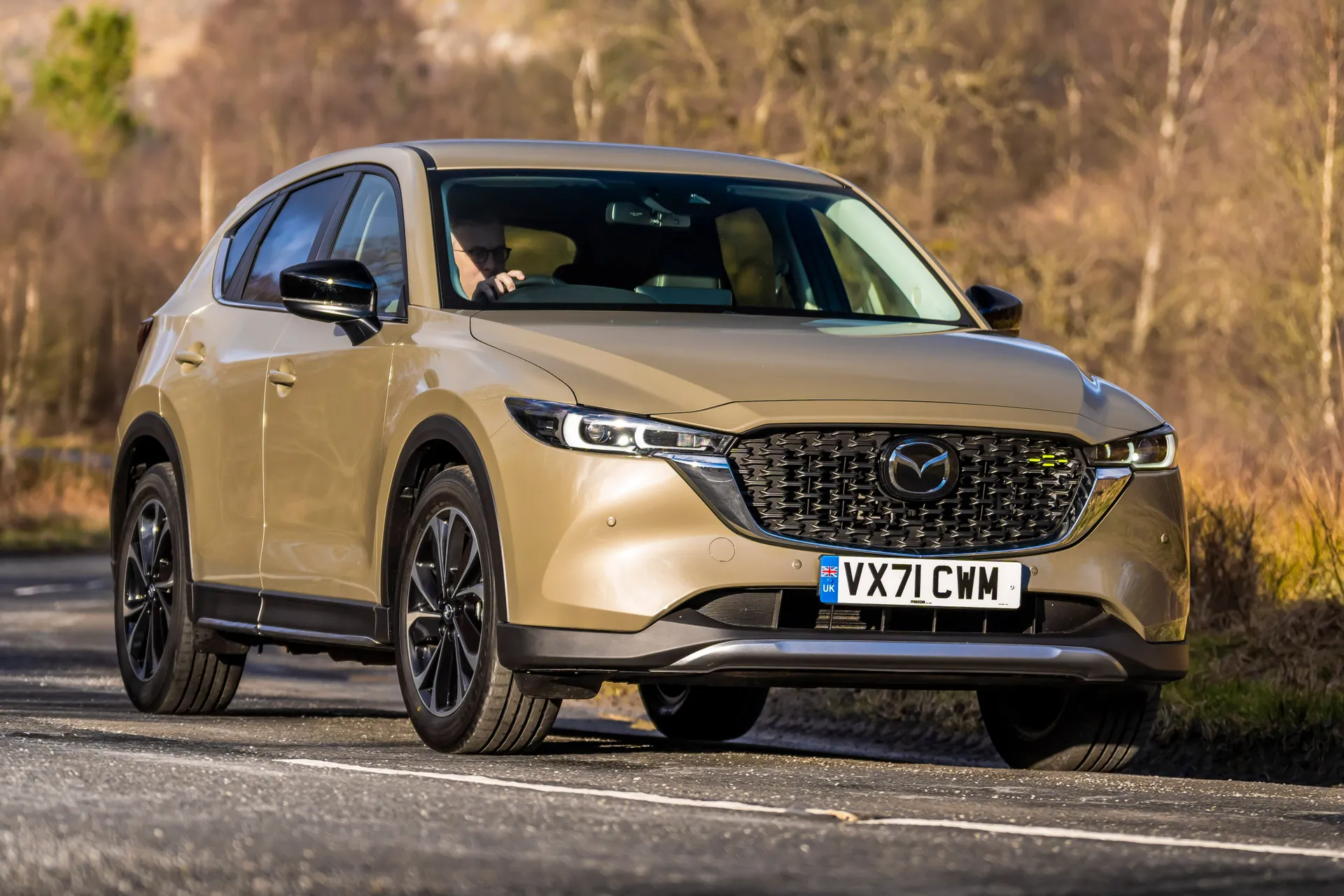
The Mazda CX-5 has been around for a fair old while, having first gone on sale in 2017. It still looks and feels as smart and as fresh as the day it went on sale, but several new and tempting contenders have come along since then, including the latest versions of the Nissan Qashqai, Kia Sportage and Hyundai Tucson. That means the competition is stronger than ever, so Mazda's given its best-selling car numerous nips and tucks along the way to keep it competitive. Have they worked? Find out in our 2024 Mazda CX-5 review..
You can now buy the Mazda CX-5 in five different trim levels: Centre-Line, Newground, Exclusive-Line, Homura and Takumi. The names of the trims have changed several times over the years (not so long ago, they were called SE-L, Newground, Sport, Sport Black and GT Sport) and minor changes have taken place over what's provided with each, but they've stayed broadly consistent for the most part. You'll fid that all cars are generously equipped, and Mazda doesn't really go big on options lists. That makes things easier if you're searching for a used Mazda CX-5.
The Mazda CX-5 is slightly bigger than its direct competitors, which means you could pitch it against larger SUVs like the Kia Sorento and Skoda Kodiaq. It's not available with seven seats, though, while it's closer to cars like the Ford Kuga, Toyota RAV4 and Honda CR-V in size. It's a very practical SUV, with a large boot, comfortable seats and a high seating position. The interior is really rather lovely, with high quality materials and an easy-to-use infotainment system. It's not an exaggeration to say that it's just as impressive as premium alternatives like the BMW X3.
If you're searching for an SUV that you'll enjoy driving every day, the Mazda CX-5 is a strong choice. It feels just as agile as the smaller SEAT Ateca, while the sharp steering and deft manual transmission provide a nod to the Mazda MX-5 sports car. It doesn't compromise on comfort, either, although you might want to look at the Citroen C5 Aircross or Volkswagen Tiguan if you want an SUV with a magic carpet ride.
Like a lot of Mazda's latest models, the CX-5 is let down slightly by its fairly mediocre engine line-up. While rivals are offering a range of self-charging hybrid and plug-in hybrid powertrains, the Mazda CX-5 sticks with conventional petrol and diesel engines. If you want a Mazda SUV that can run under electric power alone, you'll need to look at the smaller Mazda MX-30, or the larger Mazda CX-60 PHEV.
The 2.0-litre petrol will probably come up a lot in your search for a Mazda CX-5, and it’s not a bad engine. Indeed, it should be fairly frugal and no doubt very reliable. It just lacks a bit of urgency compared to turbocharged rivals. There's also a 2.5-litre petrol but, as it's only available in top trim levels with all-wheel drive, it doesn't sell in huge numbers.
The diesels are better, especially if you cover a lot of miles. We’d recommend the (now defunct) 150PS unit, unless you really need four-wheel-drive (in which case, there’s a more powerful model).
So, while rivals might be more technologically advanced, we still rate the Mazda CX-5 very highly indeed. Its interior really is lovely while, in our eyes, it's also one of the most attractive SUVs currently on sale.
Looking for a used car for sale? We've got 100s of Mazda Approved Used Cars for Sale for you to choose from, including a wide range of Mazda CX-5s for sale.
Is the Mazda CX-5 right for you?
If you’re after a stylish SUV with a superb cabin and aren’t too fussed about a premium badge, the Mazda CX-5 remains an excellent choice. It's slightly bigger than conventional family SUVs like the Nissan Qashqai, but that means it's more spacious and you get that oh-so-desirable high seating position. It's a shame you can't buy a Mazda CX-5 with a proper hybrid drivetrain, but still, it shouldn't cost a fortune to run, and it's likely to be a very reliable choice in the long-term.
What’s the best Mazda CX-5 model/engine to choose?
All Mazda CX-5 models are well equipped so we’d be inclined to look for a lower-spec model. Not only will this save you money, but you’ll also get the smaller 17-inch wheels for a more compliant ride and less road noise. Higher-spec models get 19-inch wheels, so go for one of those if you don’t mind a firmer ride and want an even classier interior.
In terms of engines, the 150PS diesel is our choice for used car buyers, because it suits the car better than the slightly lethargic 2.0-litre petrol. It might well have been our choice for new-car buyers, too, if Mazda hadn't discontinued it. Since the remaining 184PS diesel is expensive, the 165PS petrol probably makes more financial sense for most.
What other cars are similar to the Mazda CX-5?
You should also look at the Toyota RAV4 and Honda CR-V, both of which will be very sensible and reliable used choices and are available as hybrids, which might appeal if you cover a lot of town driving. You could also consider the Ford Kuga, which represents good value for money but feels dated and has a drab interior compared with the plush CX-5.
Then there’s the quirky and comfortable Citroen C5 Aircross, which has a softer ride and punchier petrol engines while, if you think you might need to occasionally carry extra passengers, we’d recommend seven-seat alternatives like the Skoda Kodiaq and Peugeot 5008.
Comfort and design: Mazda CX-5 interior
"A high seating position combined with a wide centre console, meaty dashboard and thick-rimmed steering wheel makes the Mazda CX-5 feel like a car that isn’t to be messed with. It seems much more substantial than smaller SUVs like the CX-30."
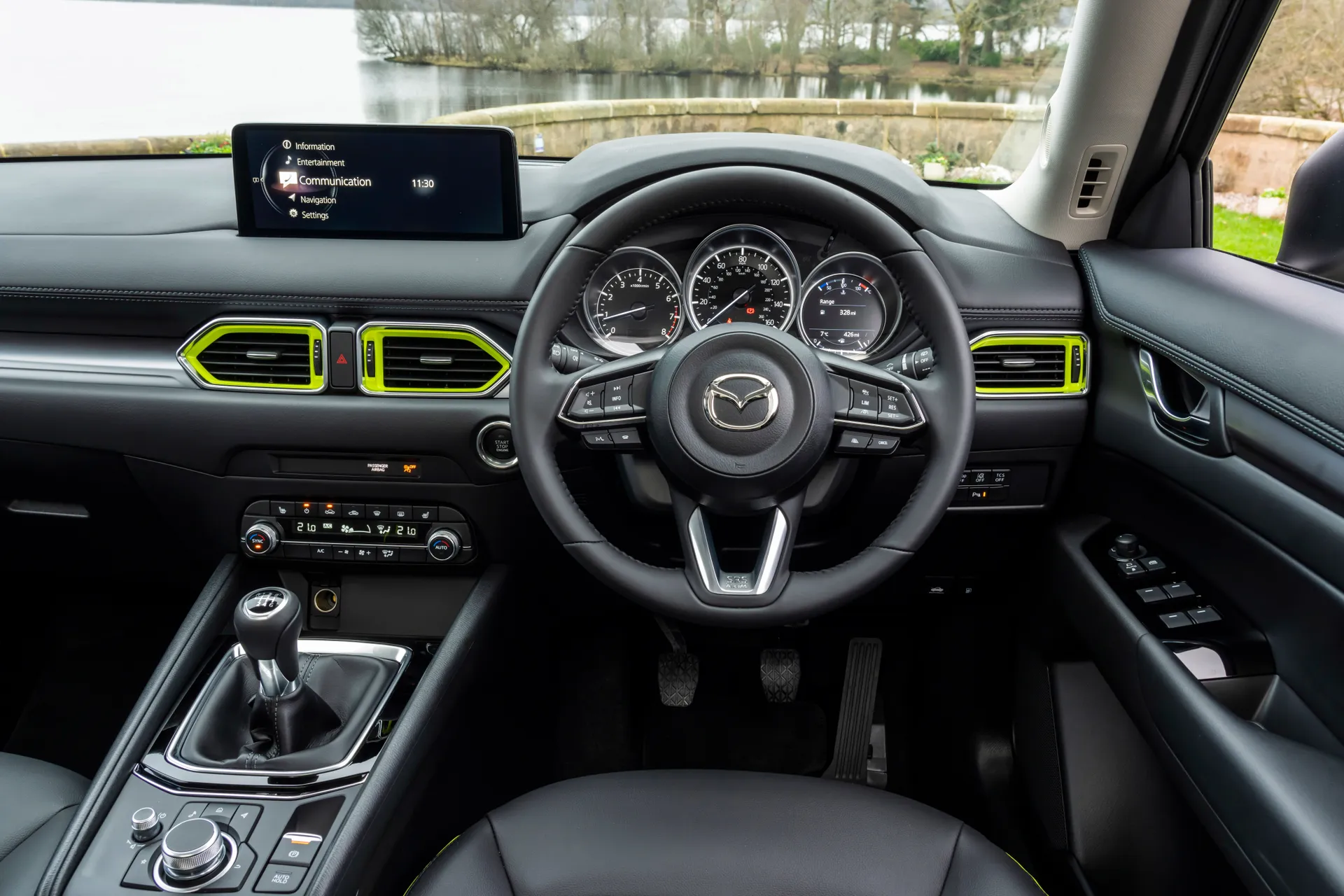
That said, it also takes quite an upmarket approach. It’s an attractive cabin to look at, with smart chrome air vents and leather in all the right places (including the seats, on all but entry-level models). Some high-spec models even come with real wood inlays which, genuinely, don’t look naff at all. You can even get fancy brown Nappa leather upholstery.
The seats are delightfully comfortable. There’s loads of adjustment in the driver and front passenger seats, including adjustable lumbar support, meaning you’re unlikely to complain about aches and pains after a long journey. Most models also come with electric seat adjustment, which is useful if you’re regularly swapping drivers.
Quality and finish
You won’t have any complaints about the quality of the CX-5’s cabin. It feels every bit the premium car, and a significant step up compared to cut-price alternatives like the Ford Kuga.
The materials used are first-rate and we have no qualms with the general fit and finish of the cabin. You won’t find any harsh plastics here, while all the switchgear feels more Audi than Skoda. Whichever model you buy, it feels just as well-made, although touches like a frameless rear-view mirror and Nappa leather seats (with seat ventilation!) make the top-of-the-range GT Sport - or later called Takumi - trim feel extra special.
We doubt you’ll hear any creaks or rattles from the Mazda CX-5’s interior on the move, and it’s sure to stand up well to day-to-day family life.
Infotainment: Touchscreen, USB, nav and stereo in the Mazda CX-5
When the Mazda CX-5 first arrived in 2017, it used a 7.0-inch navigation system, which wasn’t quite up to the same standards as the superb interior. It did the job, but the screen was a little weedier than those found in rivals, and its graphics were a bit below-par. It was slow to respond, too.
Things improved early in 2019 when Apple CarPlay and Android Auto was added as standard across the range. We rate these systems highly - just connect your phone via USB and your phone’s screen will be mirrored onto the infotainment screen. This is great as it lets you use your own navigation apps (Waze is highly recommended) and access things like your Spotify playlists or audiobooks.
Further improvements were made in 2020, when the media system was expanded to eight-inches with clearer graphics and sharper responses, while an equally impressive 10.25-inch display followed in 2021. Finally, the CX-5 got the media system it deserved.
While rivals use touchscreen systems that provide an uncluttered cabin but can be a little distracting to use on the move, the Mazda’s infotainment can be controlled via a ‘multimedia commander’ located between the front seats. This is easily operated by the driver’s left hand, allowing you to control the navigation system on the move without having to lean forward and prod the touchscreen display. It’s a set up that works very well indeed.
As well as the infotainment system, most CX-5 models come with a windscreen projected head-up display, which shows things like your current speed and navigation directions without having to take your eyes off the road. There’s a Bose surround sound system across all but the most affordable trim levels, too.
Space and practicality: Mazda CX-5 boot space
While rivals like the Skoda Kodiaq and Peugeot 5008 are all available with seven seats, the Mazda CX-5 makes do with five. That might be disappointing, but it’s not really a huge loss most of the time. In truth, the rearmost seats in most SUVs of this size are only really for occasional use, and eat into valuable boot space.
Talking of boot space, the CX-5 can carry plenty of luggage. Officially, it can fit up to 506 litres of ‘stuff’ in the back: that’s a little less than a Skoda Kodiaq or a Peugeot 5008 (when those cars' third row of seats isn’t in use), but more than smaller SUVs like the Nissan Qashqai and Kia Sportage. Drop the rear seats (using handy catches on the side of the boot) and you get a huge space, capable of carrying up to 1620 litres of luggage.
With the rear seats left up, there’s a decent amount of space in the back. The seats recline, offering a little more comfort for rear-seat passengers but, unlike in some rivals, you can’t slide the seats back and forth to let you prioritise boot or rear-passenger space.
Adults in the back will find a generous amount of headroom, but legroom is a little restricted, especially if there are tall people in the front and rear. The middle seat is quite tight in terms of width (the Citroen C5's Aircross is much more generous), and there’s an annoying lump in the floor which eats into foot room.
There’s a good view out of the side windows, even for young children, while Isofix points on the outer seats help when fitting child seats. Access is easy, too, with wide-opening rear doors and the high seating position helping when strapping kids in.
Up front, there’s loads of room. Adults won’t complain about a lack of head- or legroom, and the high centre console means you won’t be awkwardly touching your passenger’s knee whenever you change gear. There’s plenty of storage for your bits and bobs, with deep door pockets, generous cup holders and a big glovebox.
If you're hoping to fit the Mazda CX-5 in your garage, it's quite a big car. It measures 1680mm in height (with the 19-inch alloy wheels), 1845mm wide (including door mirrors) and 4575mm in overall length.
Handling and ride quality: What is the Mazda CX-5 like to drive?
"The Mazda CX-5 is significantly bigger than, say, a SEAT Ateca, and that’ll soon become evident when you try and thread it through congested city streets or into a multistorey car park."
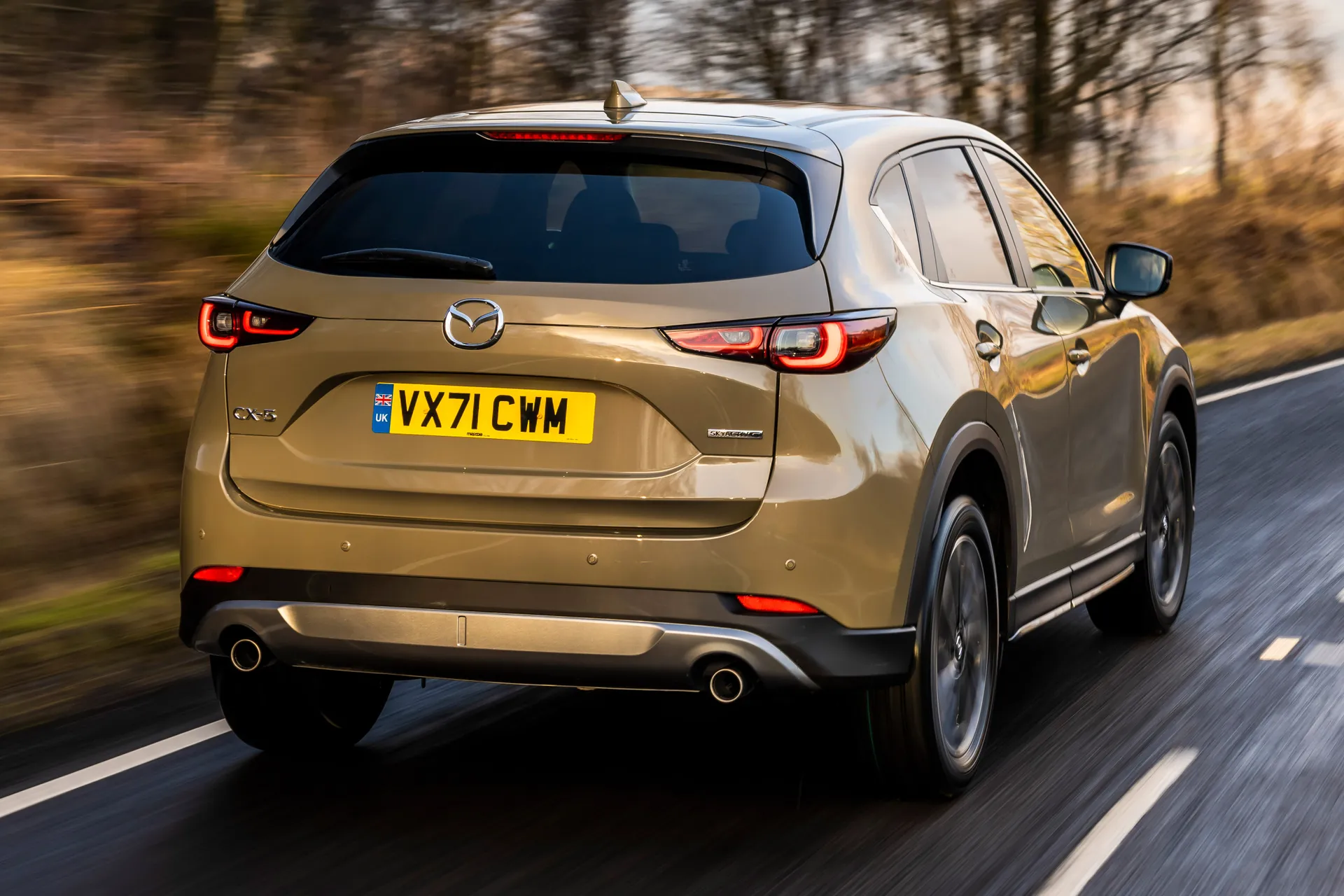
Visibility is pretty good, though, thanks to thin window pillars and a high driving position. All CX-5s come with front- and rear parking sensors, which are a massive help when reversing into tight parking spaces. Mid-range models also have a reversing camera while top-of-the-range models (once called Sport Nav+, then later GT Sport, then later still Takumi) )feature a very useful 360-degree camera.
Once you’re out of town, the Mazda CX-5 is incredibly agile for a car of its size. It’s much happier to be chucked around than a Toyota RAV4 or Honda CR-V. Not that you need to be driving quickly to appreciate its precise steering and sharper body control compared to the old CX-5.
Even the two-wheel-drive models have plenty of grip. In fact, you won’t notice much of a difference in day-to-day driving between these and those fitted with four-wheel drive. We probably wouldn’t bother with the latter unless you’re planning to lug a caravan onto a wet field.
While the CX-5 is generally quite a comfortable car, you’ll notice imperfections in the road more than you would in a Skoda Kodiaq or Citroen C5 Aircross. Those fitted with 17-inch alloys will be compliant enough for most drivers, but you’ll notice bumps more in a high-spec model with the 19-inch wheels.
What engines and gearboxes are available in the Mazda CX-5?
Historically, the best engine in the Mazda CX-5 is the 150PS Skyactiv-D diesel. The 2.2-litre turbodiesel is a gutsy unit, feeling surprisingly quick off the line thanks to all the torque available from low down in the rev range. It’s a little clattery when you give it some revs - like a lot of diesels - but it’s generally a very refined engine that copes well with a big SUV like the CX-5. Unfortunately, Mazda no longer offers this engine on brand new CX-5s, but the used car market is teeming with cars with this engine.
You can still get a brand new CX-5 with the more powerful version of this engine, with 184PS (or 175PS on early models). This is available with front-wheel drive or four-wheel drive, the latter of which will be tempting if you're looking to tow a caravan or live in a rural area. It's not that much quicker than the 150PS diesel, though, accelerating to 62mph in 9.6 seconds if you spec the automatic gearbox and all-wheel drive (compared to 10.7 seconds for the 150PS diesel auto).
While we rate the diesels in the Mazda CX-5, a petrol will make more sense for a lot of drivers. If you regularly cover short journeys, drive in town or rarely venture onto the motorway, it won’t cost you much more to run and could well be more reliable than a diesel in the long-term.
The entry-level petrol offering is the 2.0-litre Skyactiv-G petrol. With 165PS, it’ll accelerate from 0-62mph in 10.5 seconds (9.9 seconds with the automatic gearbox). That’s comparable to rivals but, as it lacks a turbocharger, you don’t get the same mid-range surge in power as you would in a 1.5 Skoda Karoq or Kodiaq.
For more punch, look for a Mazda CX-5 2.5-litre petrol which produces 194PS. It's offered only in the highest trim level with all-wheel drive and an automatic gearbox, so it's very expensive.
Refinement and noise levels
As is usually the case, the petrol engines are the most refined in the line-up. When you’re bimbling around town, the 2.0-litre petrol is very relaxed and less noticeable than the smaller turbocharged engines used in rivals. That changes as soon as you want a bit of performance, though, as you need to really build the revs to make any sort of progress. That’s fun in a sports car like the Mazda MX-5, but knocks refinement in a family SUV like the CX-5.
The diesel engine is a little grumbly, particularly when it’s getting up to temperature. By the time it’s warmed up and you’re settled into a cruise, it’s less noticeable.
No matter which engine you choose, there’s a fair bit of road noise from the 19-inch alloy wheels. As well as providing a more comfortable ride, the 17-inch rims of the entry-level car transfer less noise into the cabin.
All engines come with a choice of six-speed manual or automatic gearboxes. We’d argue that the automatic probably suits the car better, providing a relaxed driving experience with smooth changes. As a traditional torque-converter automatic gearbox, it should be a reliable option, too, although you’ll pay more for it compared to manual examples. If you’re happy to change gear, the manual gearbox is ace, with a short, direct throw that feels like it’s straight out of the MX-5 sports car.
Safety equipment: How safe is the Mazda CX-5?
The Mazda CX-5 should be a safe family car, scoring a maximum of five stars when it was crash tested by Euro NCAP in 2017. It was awarded an impressive 95% rating for adult occupants and 80% for children. Its pedestrian impact protection score was 78%, while it received a 59% rating for its safety assist features. However, this impressive rating has now expired, because Euro NCAP ratings only apply for a five-year period in the pursuit of ever-improving safety standards.
In the case of a crash, there are, of course, plenty of airbags to keep you and your passengers safe. All models come with dual front airbags, front side airbags and curtain airbags in the front and rear. There’s also a front passenger airbag cut-off switch, which is vital if a rear-facing child seat is fitted. Talking of which, there are Isofix child seat mounting points fitted to the outer rear seats.
There’s also plenty of technology to prevent you from being in a crash in the first place. Lane-Keep Assist and Lane Departure Warning systems are standard across the range, intended to keep you in your lane on the motorway, while Hill Hold Assist makes clumsy hill starts a thing of the past.
All models come with Mazda’s Advanced Smart City Brake Support, which can apply the brakes if the car detects an impending low-speed collision. This also works in reverse on top-spec models as part of the Rear Smart City Brake Support system (this was optional on Sport/Exclusive-Line trims as part of the Safety Pack).
Said Safety Pack was an £800 feature when new and is desirable on used models. As well as the Rear Smart City Brake Support system, it also added adaptive LED headlights, Driver Attention Alert and a 360-degree view camera. The latter is very useful when parking.
MPG and fuel costs: What does a Mazda CX-5 cost to run?
"If outright economy is high on your wishlist, look for a lower-powered 150PS diesel with the manual gearbox. Officially this returns 50.4mpg under WLTP fuel economy tests, which is pretty impressive for a car of this size. Of course, it depends on a number of factors, so don’t expect such frugality if you’re heavy with the throttle or mainly drive around town."
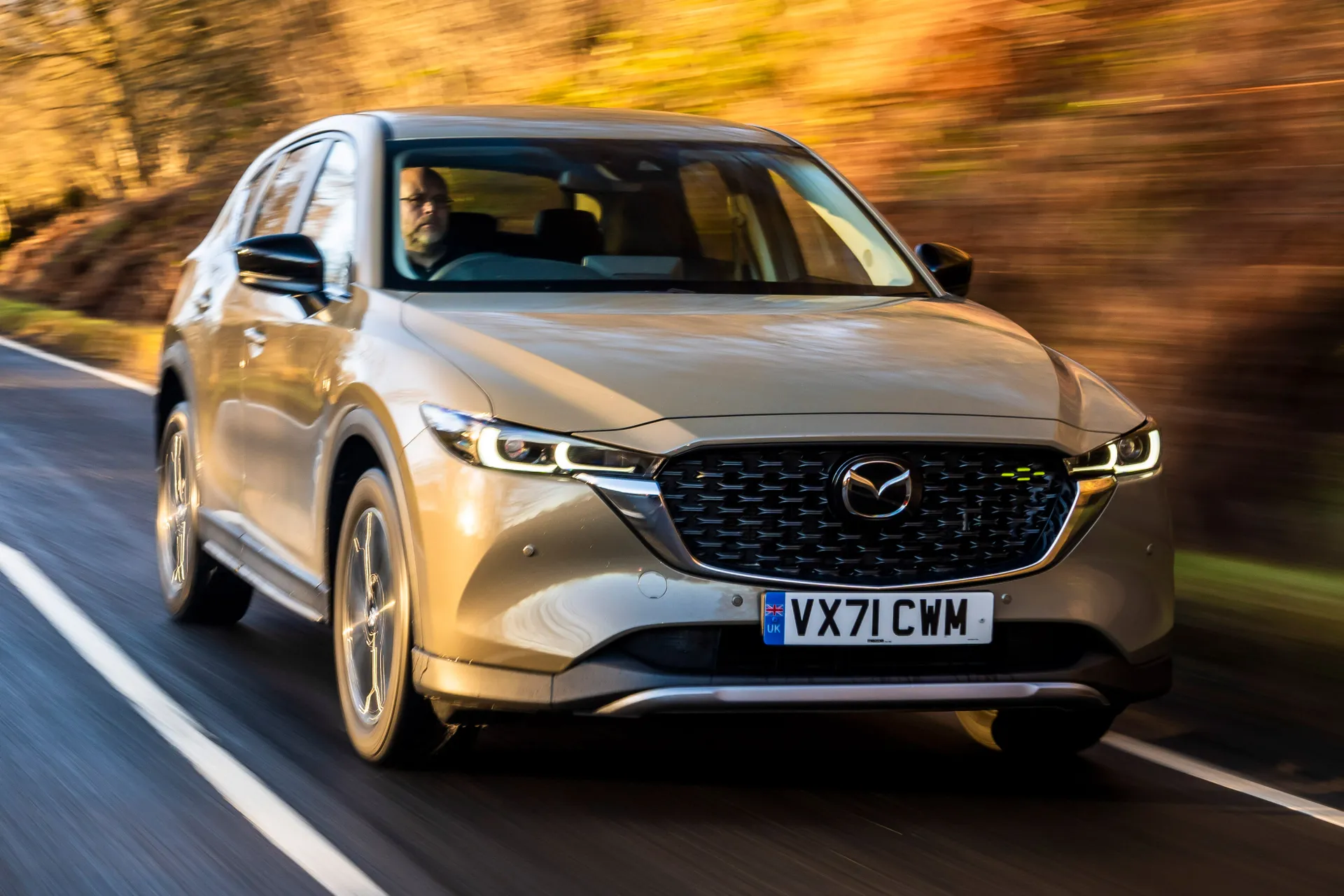
The more powerful, all-wheel-drive diesels are a little less efficient, returning 44.8mpg with the manual gearbox and 42.8mpg as an auto.
The petrols are a bit thirstier, with the 2.0-litre returning 41.5mpg with the manual gearbox and 38.2mpg as an auto. Unsurprisingly, the 2.5-litre AWD petrol returns a pretty dismal 35.8mpg. The good news is that Mazda’s naturally-aspirated petrol engines tend to return pretty close to their official figures in the real world.
How reliable is a Mazda CX-5?
Mazda generally has an excellent reliability record and the CX-5 is no exception. We've had very few issues reported with the latest Mazda CX-5, bar a few minor infotainment niggles. Mazda ranked 15th in the latest HonestJohn.co.uk Satisfaction Index.
Insurance groups and costs
The cheapest Mazda CX-5 to insure is the Skyactiv-G petrol in SE-L trim. This falls into insurance group 14, while plusher petrol models are categorised as group 15 or 16. The difference between them will be negligible but shop around for quotes if you’re concerned.
Diesel models are a little more expensive to insure, starting from group 19 for the SE-L with the 150PS, increasing to between 23 and 27 for the more powerful engine with four-wheel drive. This isn’t monstrously high, though, and is pretty much in line with rivals.
VED car tax: What is the annual road tax on a Mazda CX-5?
All Mazda CX-5s registered since 1 April 2017 will be subject to tax at a flat rate of £190 a year. That’s the same as rivals - unless you look at a hybrid model like the Honda CR-V, which will save you £10 a year.
There is a premium tax of an extra £390 a year for all cars with a list price of more than £40,000 (that’s how much it retailed at when new). With a limited options list, there are only a couple of high-end versions on which you can actually spend that much, but ask the question if you’re looking at a particularly fully-loaded example.
How much should you be paying for a used Mazda CX-5?
"With new prices starting in the region of £31,000 and rising to around £43,000, the Mazda CX-5 is quite an expensive SUV considering it hasn’t got a premium badge. There are some very tempting bargains to be had on the used and nearly-new markets, though."
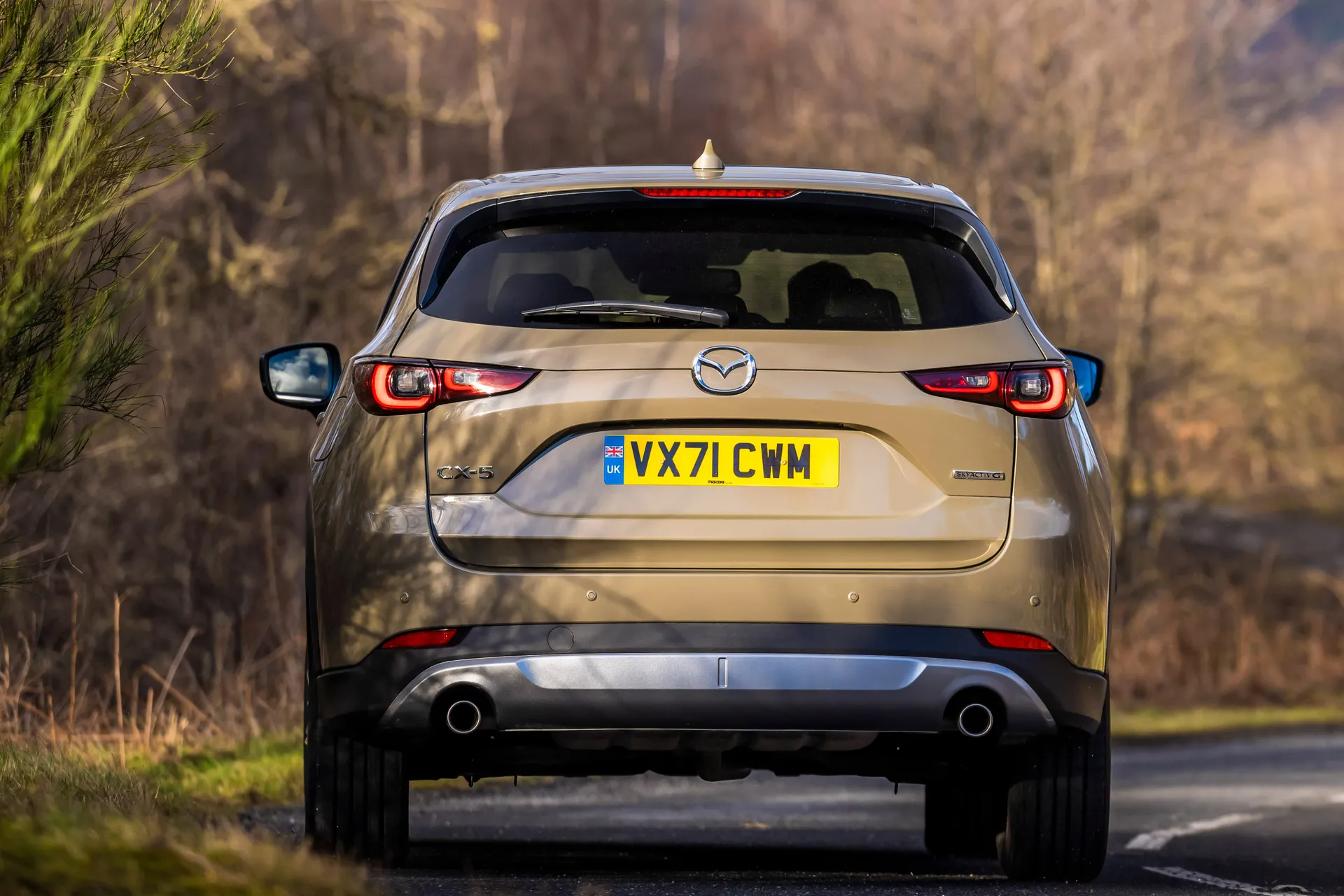
If you want a car that’s like new, consider a pre-registered example. These are cars that have been ordered and registered by dealers to help them meet targets, before being sold for less than the retail price. You can get a bargain this way and skip the waiting list, although you won’t be able to pick things like colours and options. However, as Mazda doesn’t offer much in the way of options anyway, that’s not a huge loss in this case.
The cheapest CX-5s in our listings check in at about £14,000. For this money, you can expect the less powerful petrol and diesel engines to be available, paired with mid-range trim levels. The car will likely have been made between 2017 and 2019, and should have between 40,000 and 60,000 miles on the clock.
Trim levels and standard equipment
The Mazda CX-5 line-up has changed a few times since it first went on sale in 2017, so you’ll have to pay attention.
It was initially offered in just two trim levels: SE-L Nav and Sport Nav. Both were loaded with kit, including LED headlights, auto power-folding door mirrors, dual-zone climate control, DAB radio and a seven-inch colour touch-screen display with Mazda’s integrated navigation.
The Mazda CX-5 Sport Nav added to this with a host of premium highlights including a reversing camera, eight-way power-adjustable driver’s seat and Smart keyless entry, plus heated front seats and steering wheel. Sport Nav models also featured a power lift tailgate, plus a new head-up display (HUD) that projects directly onto the windscreen and features Traffic Sign Recognition.
There was a minor update in 2018, when the CX-5 SE-L Nav became the SE-L Nav+ and the Sport Nav became, you guessed it, the Sport Nav+. The main changes in terms of the specification is the addition of extra active safety equipment as standard, with Mazda Radar Cruise Control, Advanced Blind Spot Monitoring with Rear Cross Traffic alert, Smart Brake Support, High Beam Control and Lane Keep Assist with Lane Departure Warning now standard across the range, while the optional safety pack on Sport Nav+ models now features a 360-degree camera and Adaptive LED Headlamps.
From 2020, the most affordable model in the CX-5 line-up was the SE-L. This came pretty well equipped, with highlights including 17-inch alloy wheels, LED headlights and rear privacy glass. Inside, there’s black cloth trim, an electronic parking brake and an eight-inch navigation system. Front and rear parking sensors are also standard, as is a host of safety technology such as hill hold assist, lane-keep assist and intelligent speed assist (that’s a lot of, er, assists…).
The Mazda CX-5 Sport starts to feel like a more premium choice, with 19-inch alloy wheels, a reversing camera, electric tailgate and, with certain engines, a sunroof. It also gets electrically-adjustable heated front seats, a heated steering wheel, keyless entry and a premium Bose surround sound system.
Topping the range is the Mazda CX-5 GT Sport model which adds Nappa leather seats, ventilated front seats (don’t knock ‘em until you’ve tried them) and heated outer rear seats. There’s wood trim, bespoke steering wheel stitching and interior LED lighting, while the Safety Pack brings with it adaptive headlights, Driver Attention Alert, Rear Smart City Brake Support and a 360-degree view monitor.
The Mazda CX-5 range was tweaked again in 2022. It still starts with the Mazda CX-5 SE-L, which comes with 17-inch alloy wheels, black cloth trim, a 10.25-inch media system (with Apple CarPlay and Android Auto) and an extensive list of driver-assist tech.
The new Mazda CX-5 Newground adds 19-inch black diamond-cut alloy wheels, black mirror caps, lime green accents and silver front/rear under guards and side skirts. Inside, the CX-5 Newground features black half leatherette seats with suede inserts and lime green stitching, six-way power adjustment in the driver's seat, heated front seats and lime green interior highlights.
The Mazda CX-5 Sport builds on the SE-L with 19-inch diamond-cut alloy wheels, a reversing camera, power tailgate and a power sunroof. There's black, heated leather seats inside as well as a head-up display, wireless phone charging and a premium Bose surround sound system.
The Mazda CX-5 Black features black exterior highlights (including the 19-inch alloy wheels), interior lighting, wireless phone charging and premium Bose sound system with 10 speakers.
Topping the range is the Mazda CX-5 GT Sport, which features 19-inch silver alloy wheels, body-coloured exterior highlights, brown Nappa leather, heated rear seats and ventilated front seats, wood trim and unique sreering wheel stitching. It also gets a 360-degree view monitor, adaptive LED headlights, driver attention alert and rear smart city brake support.
The range was tweaked yet again in 2023. The trim levels available were renamed Centre-Line, Newground, Exclusive-Line, Homura and Takumi. Equipment levels were broadly the same as before, with pretty much just the names being changed.
Ask the heycar experts: common questions
Is the Mazda CX-5 a good car?
Where is the Mazda CX-5 made?
Is the Mazda CX-5 reliable?
What is Skyactiv technology?
Get our latest advice, news and offers
Keep me updated by email with the latest advice, news and offers from heycar.
By submitting you agree to our privacy policy



